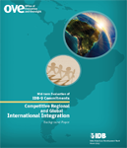IDB-9: Competitive Regional and Global International Integration
Date
Mar 2013
Trade and regional integration in Latin America and the Caribbean (LAC) have been constant goals of the Inter-American Development Bank (IDB, or Bank) since its inception. While the Bank has historically had a very active role in policy discussions with and technical assistance to countries on these issues, it has not had a substantial regional lending program in this area. Indeed, the trade and integration portfolio is divided between the nonlending part, mostly led by the Trade and Integration Sector, and the infrastructure integration part (where the bulk of the lending is concentrated), led by the infrastructure sector. However, this lending portfolio is composed almost exclusively of national projects with typically no proven regional benefits beyond the purely national ones. The main reason for the paucity of projects with regional benefits is that working regionally is associated with higher transaction costs for both the Bank and the countries, and the Bank still lacks a concessional lending instrument. Under the IDB-9 Agreement, the Bank reiterated regional integration as one of the priorities, attaching a specific lending target to it. Management was required to produce a new regional integration strategy and an action plan to guide the actions of the Bank. The new Integration Strategy has a thorough understanding of the nature of the challenges to regional integration and contains a complete and sound diagnosis of trade issues in LAC. Although the diagnosis of infrastructure integration and regional public goods is weaker, the Strategy remains relevant to identify the main challenges and the recent evolution of trade and integration in LAC. The Strategy and Action Plan provide little guidance, however, beyond outlining the main ideas. Although a first draft identified the need for concessional instruments, the final version proposed only a "smart mix" of existing instruments. The Strategy does not clearly define and build on the Bank¿s comparative advantage or record of past experience. The definition and classification of "regional integration projects" are confused; depending on the source chosen, regional integration projects represent between 0.6% and 25% of Bank lending in 2011. The baseline for lending in the IDB-9 Agreement (10%) is unrealistic given the Bank's historic performance, and projects without any connection with either regional integration or the Integration Strategy are being labeled as regional. The Strategy and the Action Plan mostly describe what the Bank currently does rather than provide strategic leadership or direction. The Bank is now at a crossroads. Different options are available depending on the risk appetite of Governors and the willingness of the LAC Region to advance toward regional integration. Instead of pursuing the current low-risk and low-payoff strategy, Governors may wish to tackle the problems that have precluded lending for regional integration, including providing preferential access to resources for regional integration projects with clear eligibility guidelines. In any case Management should revisit its classification system for regional lending and provide a more transparent and more accurate picture of actual Bank work in this area.



